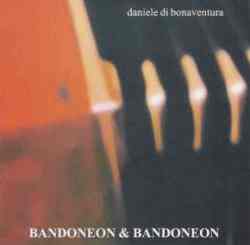The Free-Reed Review
Critiques of Compact Discs, Books and Music Scores
CD Review: Daniele di Bonaventura: Bandoneon & Bandoneon

Total time: 52:40
Released in September 2000
Review Date: January 2001
Label: Felmay
Strada Roncaglia, 16
15040 San Germano (AL) - Italy
website: http://www.felmay.it
e-mail:
Tel: 39 - 0142 - 50577
Fax: 39 - 0142 - 50780
Artist's e-mail:
|
Daniele di Bonaventura, bandoneon and piano
Catia Violoni, voice
Program:
- Jeanne y Paul: A. Piazzolla
- Intro / Candombe: D. di Bonaventura
- Milonga & tango dell'assenza: D. di Bonaventura
- El penultimo: A. Piazzolla
- Canto al sole: D. di Bonaventura
- Azulejos: D. di Bonaventura
- Kyrie: D. di Bonaventura
- El viaje: A. Piazzolla & F. E. Solanas
- Maria: A. Troilo & C. Castillo
- Preghiera a mio padre: D. di Bonaventura
- Vola vola (traditional Abbruzzese melody)
|
Review by Gregory A. Vozar
If there were a prize for creativity and originality in the category of
bandoneon composition and performance, Daniele Di Bonaventura's compact disc
Bandoneon & Bandoneon would be a serious contender for top honors.
In spite of the current rarity of the instrument, production having
virtually ceased before the end of World War II, enthusiastic audiences
still patronize a healthy number of professional and amateur tango players.
In addition, musicians in the middle European folk tradition and a small but dedicated group of concert bandoneonists maintain their own literature.
While these groups have been very important to the preservation of the
instrument and to their individual musical backgrounds, none of them have
managed to bring the bandoneon totally out of its ethnic closet.
Daniele Di Bonaventura comes closer than anyone in allowing an old
instrument to sing with a new voice. He draws inspiration from diverse
cultures and styles: Latin Jazz, the Middle East, sacred themes and Italian
folk music. He is also an admirer of tango nuevo and Astor Piazzolla, whose music he plays on this album along with his own compositions. However, it is not just the eclectic nature of his material that may attract
listeners but the stylish way in which he plays it on his instrument.
How fortunate it is that Daniele di Bonaventura possesses the equivalent
of a free-reed Stradivarius; his concertina (Alfred Arnold 1933) sings
with the resonance of a cello, especially in the tenor and bass registers.
That lends a warm and comfortable tonal ambience to the entire recording.
The thin wooden case and soundboards of the instrument vibrate and pulse in sympathy with the reeds,
making it feel very much alive in the hands of a musician. That sense of
intimate vitality is audible on nearly every track of this album, from the
rustle and sigh of the bellows to the subliminal "pat" of wood and leather
valves closing. These sounds are as much a part of making music on the
instrument as is the scrape of a rosined bow on violin strings. Only here,
Di Bonaventura subtly employs these involuntary reflexes as musical
punctuation and accents.
The disc opens with Piazzolla's feline Jeanne y Paul, followed by the improvisatory mystery of Di Bonaventura's own Intro / Candombe. For
those unfamiliar with the form, the candombé was originally a
vigorous, syncopated dance of Afro-Uruguayan origin, often accompanied by
drums. Here, however, the artist lightly sketches it in a breathy, marcato
style. We then settle down to cool gray skies and rain spotted windows when
listening to the pensive paired melodies of the Milonga / Tango
dell'assenza that follow. The first piece is a piano solo, the second a
duet for bandoneon and piano, both instruments played by the same artist.
Spirituality is not lacking on this recording, whether it be the vibrant
deference paid the Italian sun in the artist's Canto al sole or the
introspective, organ-like chords that open his Kyrie. Perhaps the
most moving of all is the simple, loving tribute to his father, Preghiera a mio padre. The bandoneon is admirably suited for this type of music,
for Heinrich Band, its inventor, gave his concertina its peculiar timbre
because he intended it as an inexpensive substitute for the organ in small
or poor parishes that could not afford a large, expensive instrument. Di
Bonaventura has rediscovered this aspect of the bandoneon's voice.
At first, the title of this compact disc, Bandoneon & Bandoneon,
appeared to be a misnomer, for the cover gives the names of two artists,
only one whom plays the bandoneon. (Daniele di Bonaventura is assisted by
the aptly named Catia Violoni, a singer whose chesty voice may be heard on
Piazzolla's El viaje and Aníbal Troilo's tango Maria.)
Listening carefully to the instrumental textures of many pieces, I realized
that the bandoneonist made extensive use of dubbing and multiple track
recording techniques, sometimes accompanying himself on a second bandoneon
or piano.
The only rough spots on this compact disk were the vocalist's spotty
intonation problems, but these are only a minor distraction. On the whole,
the recording made a very positive impression on me. The artist prefers to
persuade rather than dazzle, and such modesty can be very becoming. It
certainly is refreshing to listen to a young musician-composer who upholds
ideals of poetry and harmony, abstaining from the abrasive and angry
scratching of so much contemporary music. Daniele di Bonaventura ultimately
leaves me with a sense of hope, hope for the future viability of the
bandoneon in the pantheon of musical instruments and hope that there will be
other artists who are not afraid to remind us, after all is said and done,
that Heinrich Band's instrument was originally meant to accompany a church
choir!
